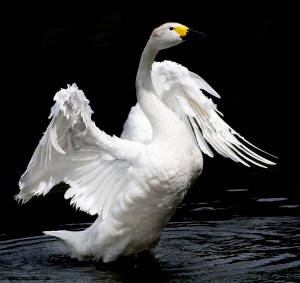The swan with the special something

It could be our love of the underdog or perhaps the mystery shrouding their spring and summer absence but there is definitely something special about Bewick’s swans.
WWT founder Sir Peter Scott certainly enjoyed them, designing a purpose built lake, overlooked by his house in Slimbridge, which he hoped would become a new wintering site for the species.
Now, the long, two-story Peng Observatory, only yards from Sir Peter’s former home, lures hundreds of people in winter to watch daily swan feeds at the lake at which Bewick’s are a star attraction.
To date, 29 Bewick’s have flown into Slimbridge including five cygnets with their parents Croupier and Dealer. The reappearance of the faithful couple continues one of Slimbridge’s longest Bewick’s lineages, expert Julia Newth says in her entertaining and informative Bewick’s Swan Diary. The group are likely to feature on BBC Autumnwatch tonight.
All but the youngest Bewick’s are identified by their bill patterns and named by WWT researchers. This helps visitors check their life-histories and wellbeing.
Croupier’s grandparents, Caroline and Nijinsky, first visited Slimbridge in 1969 and two years later returned with two cygnets, one of which was Croupier’s mother, Casino.
“Casino became a Slimbridge faithful, visiting for 26 years of her life,” Julia writes. “For many years, she was the oldest bird to have visited the reserve but this has been surpassed by Winterling who will be 29 years old if she returns this winter!”
Bewick’s fly more than 1,800 miles on migration from breeding grounds in Arctic Russia.
“For most of the 20th century, we knew very little about their summer haunts because western ornithologists had no access to these isolated areas,” Julia says.
“So there was always this mystery about where they’d come from. They’re so elegant and refined and they have this evocative bugling call. They capture people’s imaginations.”
The arrival of the Bewick’s at Slimbridge has caused quite a stir not least among indignant resident mute swans.
Not used to sharing the lake, the mutes do “all they can to puff themselves up, look scary and chase them off”, Julia chuckles. It is to no avail, with the Bewick’s “far more nifty and nimble, literally swimming circles around the mutes”.
Between 300 and 400 Bewick’s are likely to overwinter at Slimbridge, a western outpost for the species. Some are ringed at the centre enabling dedicated wildlife watchers across six countries to follow their migration.
One bird, Dario, is often seen. Julia explains: “We know roughly how many kilometres he’s flown over his lifetime, how many times he’s returned to Slimbridge, his breeding success and who he’s paired with.
The stories revealed by WWT’s research encourage widespread interest in the species. “As well as helping us to understand their requirements to survive, bill pattern studies have drawn attention to the bird’s decline and enabled us to talk about conservation concerns.”
Research is ongoing and among new studies of Bewick’s are two which could court controversy. It is illegal to shoot the species in any country through which they pass and WWT is working with hunting organisations to reduce this threat.
The Trust is also assessing the potential for overlap between the swan’s migration route and proposed wind farm sites, particularly an offshore area between the Dutch and Norfolk coasts.
Bewick’s are seen at three WWT centres other than Slimbridge. Small flocks sometimes venture to Martin Mere from nearby farmland, Bewick’s also overwinter at Arundel in West Sussex while Welney is the most important UK wintering site for the birds, attracting up to 6,000 Bewick’s in winter together with 5,000 whooper swans.
Go and see them on one side of the country or the other and we guarantee a special something will mark your day.
- Planning ahead? How about a trip to the Slimbridge Festival of Birds on 4-5 February 2012 (link to add)

